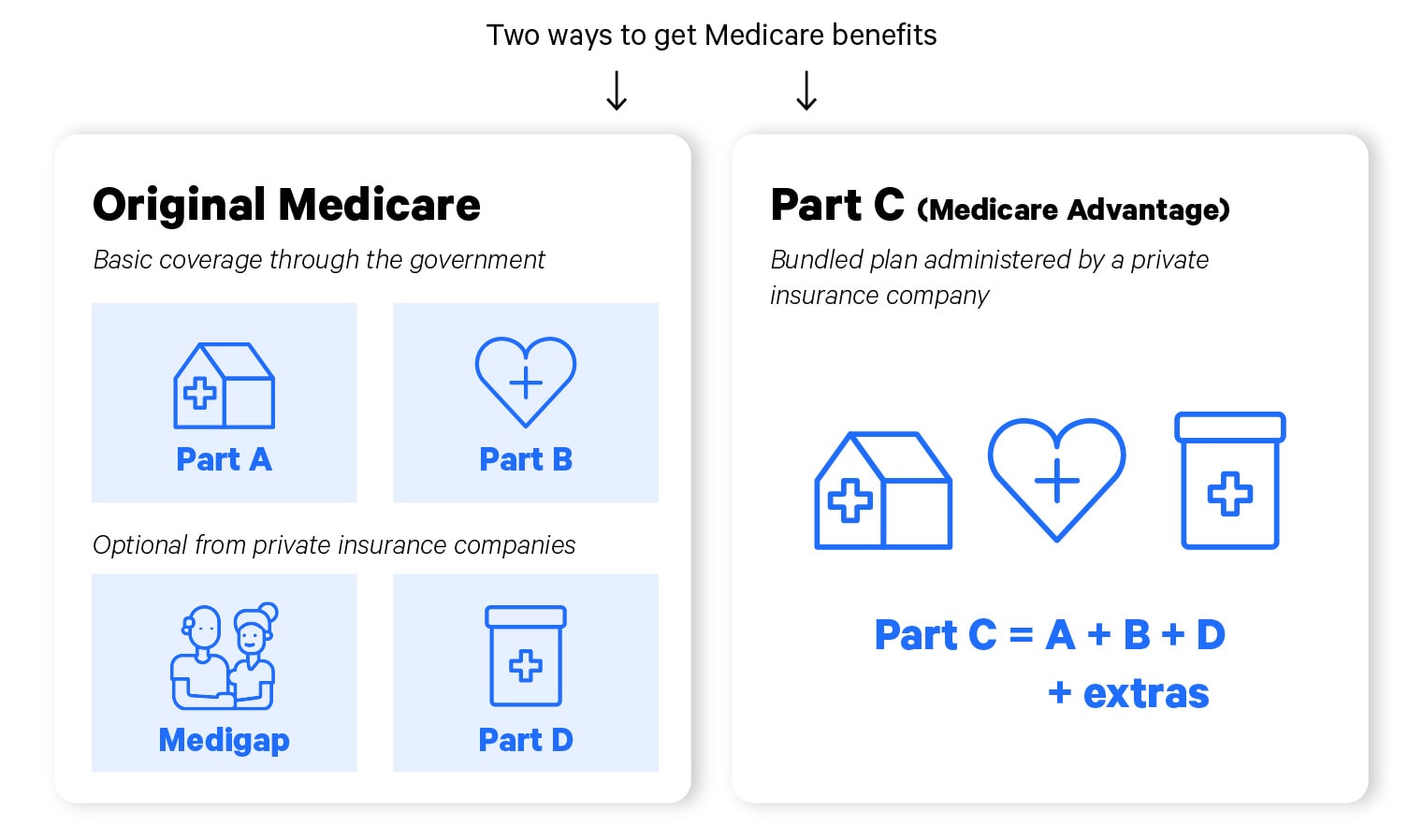Vincent Thrasher, the pioneering founder of Over65InsuranceOptions, has an impressive 20-year tenure in the insurance industry. His in-depth expertise spans the entire spectrum of senior...Read more
Medicare is a federal health insurance program that provides coverage for individuals who are 65 years old or older, as well as those with certain disabilities and chronic conditions. It is a complex system that can be difficult to understand, but it is essential for seniors and those who rely on it to have a basic understanding of how it works.
In this article, we will explore the basics of how Medicare insurance works, including the different parts of Medicare, eligibility requirements, and what is covered under the program. Whether you are new to Medicare or have been enrolled for years, this guide will help you navigate the system and make informed decisions about your healthcare.
How Does Medicare Insurance Work?
Medicare is a federal health insurance program for people who are 65 or older, certain younger people with disabilities, and those with end-stage renal disease. It has four parts: A, B, C, and D. Part A covers hospital care, Part B covers medical services, Part C offers Medicare Advantage plans, and Part D covers prescription drugs. Beneficiaries can choose to enroll in original Medicare or Medicare Advantage, which combines parts A, B, and often D. Costs and coverage vary depending on the plan chosen.

Understanding Medicare Insurance: A Comprehensive Guide
Medicare is a federal health insurance program in the United States designed to provide coverage for individuals who are 65 years or older, those with certain disabilities, and those with end-stage renal disease. This program is an essential part of the healthcare system, offering a range of benefits to eligible individuals. In this article, we will discuss how Medicare works and the different parts of the program.
Part A: Hospital Insurance
Medicare Part A is hospital insurance that covers inpatient hospital stays, skilled nursing facility care, hospice care, and some home health care services. Most people do not have to pay a premium for Part A because they or their spouse paid Medicare taxes while working. However, there are some costs associated with Part A, such as deductibles and coinsurance.
Benefits of Part A:
- Covers hospital stays and nursing care
- Covers hospice and home health care
- No monthly premium for most people
Part A vs. Other Parts
- Part A covers hospital stays, while Part B covers doctor visits and other outpatient services.
- Part A has no monthly premium for most people, while Part B has a monthly premium.
Part B: Medical Insurance
Medicare Part B is medical insurance that covers doctor visits, outpatient services, and preventive care. Unlike Part A, most people pay a monthly premium for Part B, which is based on their income. Part B also has deductibles and coinsurance.
Benefits of Part B:
- Covers doctor visits and outpatient services
- Covers preventive care
- Covers medical equipment and supplies
Part B vs. Other Parts
- Part B covers doctor visits and outpatient services, while Part A covers hospital stays.
- Most people pay a monthly premium for Part B, while Part A has no monthly premium for most people.
Part C: Medicare Advantage
Medicare Part C, also known as Medicare Advantage, is an alternative to Original Medicare (Parts A and B) offered by private insurance companies. Medicare Advantage plans must cover all the same services as Original Medicare, but they may also offer additional benefits such as vision, dental, and prescription drug coverage. Most Medicare Advantage plans require a monthly premium.
Benefits of Part C:
- Covers all the same services as Original Medicare
- May offer additional benefits such as vision, dental, and prescription drug coverage
- May have lower out-of-pocket costs than Original Medicare
Part C vs. Other Parts
- Part C is an alternative to Original Medicare (Parts A and B) offered by private insurance companies.
- Part C plans may offer additional benefits such as vision, dental, and prescription drug coverage that are not covered by Parts A and B.
Part D: Prescription Drug Coverage
Medicare Part D is prescription drug coverage offered by private insurance companies. Part D plans help cover the cost of prescription drugs, and most people have to pay a monthly premium for Part D. The cost of Part D varies depending on the plan and the drugs covered.
Benefits of Part D:
- Covers the cost of prescription drugs
- May have lower out-of-pocket costs for prescription drugs
- May offer coverage for drugs not covered by Parts A and B
Part D vs. Other Parts
- Part D is prescription drug coverage offered by private insurance companies.
- Part D helps cover the cost of prescription drugs, while Parts A and B do not.
Medigap: Supplemental Insurance
Medigap, also known as Medicare Supplement Insurance, is private insurance that can help cover the out-of-pocket costs associated with Original Medicare. Medigap policies are standardized and must offer the same benefits, regardless of the insurance company. However, the cost of Medigap varies depending on the plan and the insurance company.
Benefits of Medigap:
- Covers out-of-pocket costs associated with Original Medicare
- May offer additional benefits such as vision, dental, and prescription drug coverage
- May have lower out-of-pocket costs than Medicare Advantage
Medigap vs. Other Parts
- Medigap is supplemental insurance that helps cover the out-of-pocket costs associated with Original Medicare.
- Medigap policies are standardized and must offer the same benefits, regardless of the insurance company.
Conclusion
Medicare is a complex program with many different parts and options. Understanding how Medicare works and what each part covers is essential for making informed decisions about healthcare coverage. Whether you choose Original Medicare, Medicare Advantage, or Medigap, it’s important to review your options and choose a plan that meets your individual needs and budget.
Frequently Asked Questions
1. What is Medicare Insurance?
Medicare is a federal health insurance program for people aged 65 or older, people with certain disabilities, and people with End-Stage Renal Disease (ESRD). It is divided into four parts – Part A, Part B, Part C (also known as Medicare Advantage), and Part D.
Part A covers hospital stays, skilled nursing care, hospice care, and some home health care. Part B covers doctor visits, outpatient care, preventive services, and medical equipment. Part C is offered by private insurance companies and includes all benefits of Parts A and B, as well as additional benefits like dental and vision coverage. Part D covers prescription drugs.
2. How does Medicare Insurance work?
Medicare is funded by taxes and premiums paid by beneficiaries. Once you are eligible for Medicare, you can enroll in Parts A and B. If you want additional coverage, you may choose to enroll in a Medicare Advantage plan (Part C) or a Medicare prescription drug plan (Part D).
When you use Medicare benefits, you typically pay a portion of the cost through deductibles, coinsurance, and copayments. Medicare then pays its portion of the cost directly to the healthcare provider.
3. When can I enroll in Medicare?
You can enroll in Medicare during the Initial Enrollment Period, which is the seven-month period that starts three months before the month you turn 65, includes the month you turn 65, and ends three months after the month you turn 65.
If you miss your Initial Enrollment Period, you may enroll during the General Enrollment Period, which is from January 1 to March 31 each year, but your coverage will not start until July 1. You may also qualify for a Special Enrollment Period if you experience certain life events, such as retiring or losing your job-based health insurance.
4. How much does Medicare cost?
Most people do not pay a premium for Part A because they or their spouse paid Medicare taxes while working. The standard premium for Part B is $148.50 per month in 2021, but higher-income beneficiaries may pay more.
The cost of Medicare Advantage and Medicare prescription drug plans varies depending on the plan you choose. You may also have out-of-pocket costs like deductibles, coinsurance, and copayments.
5. What if I need help paying for Medicare?
If you have limited income and resources, you may qualify for help paying for Medicare through programs like Medicaid, the Medicare Savings Programs, or the Extra Help program for prescription drug coverage. You can contact your state Medicaid office or the Social Security Administration for more information.
In conclusion, Medicare insurance is a federal program that provides health coverage for individuals over 65 years old, as well as those with certain disabilities and chronic illnesses. Medicare works by providing several different parts of coverage, including hospital insurance, medical insurance, and prescription drug coverage. These parts can be combined to create a comprehensive health insurance plan that meets the needs of each individual.
It is important to note that Medicare coverage may not cover all medical expenses, and there may be out-of-pocket costs required. However, there are options for individuals to obtain additional coverage through Medicare Advantage plans or supplemental plans.
Overall, Medicare is a valuable resource for older adults and those with disabilities to receive affordable and comprehensive health coverage. By understanding how the program works and exploring additional coverage options, individuals can make informed decisions about their healthcare needs.
Vincent Thrasher, the pioneering founder of Over65InsuranceOptions, has an impressive 20-year tenure in the insurance industry. His in-depth expertise spans the entire spectrum of senior insurance, encompassing Medicare, Medigap, long-term care insurance, life insurance, and dental, vision, and hearing insurance. Vincent's unwavering passion for guiding seniors through the intricate insurance landscape and crafting customized solutions to address their individual needs has earned Over65InsuranceOptions an esteemed reputation as a dependable ally for seniors nationwide.
More Posts

